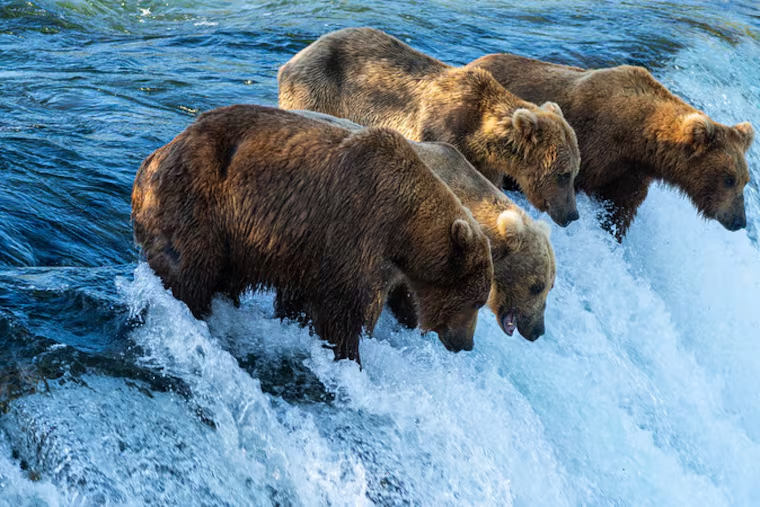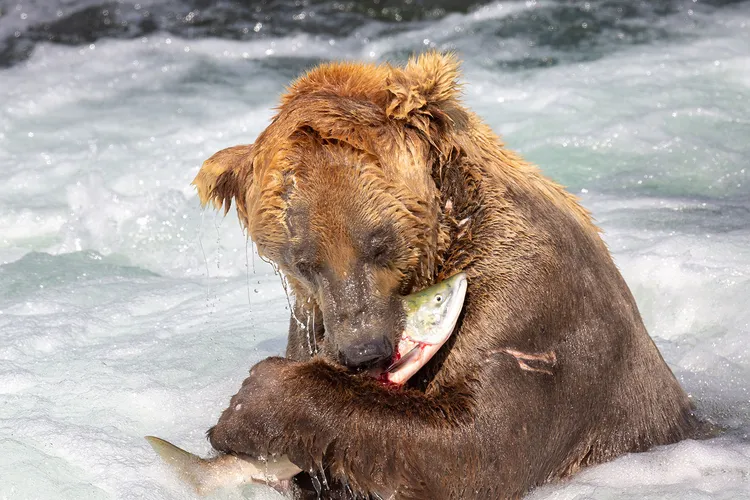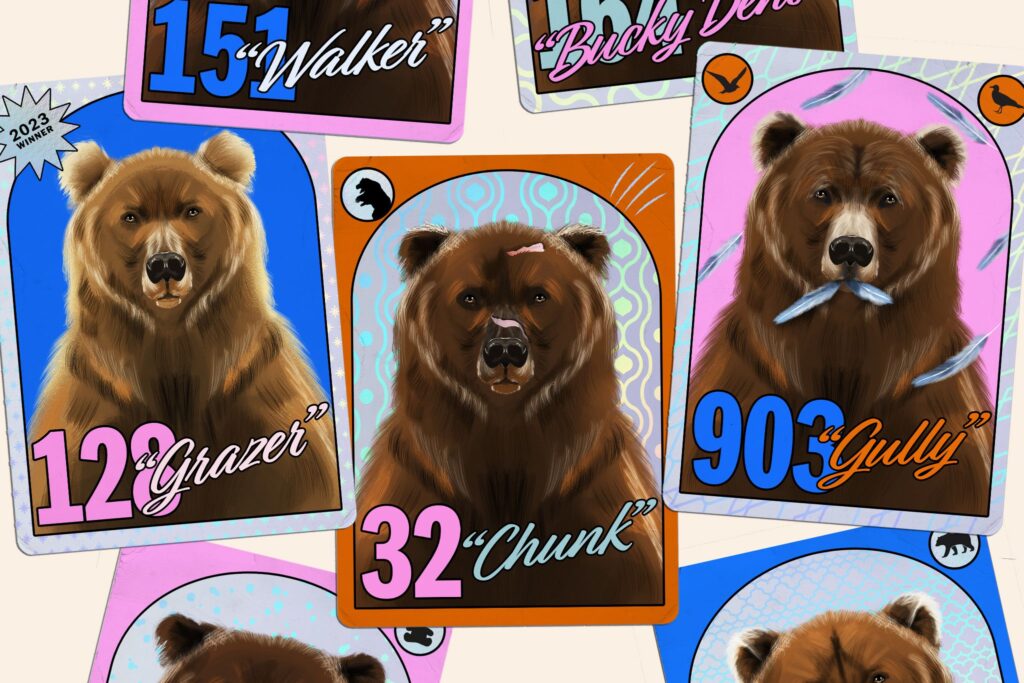“Bigger is better when winter’s coming—here’s why Fat Bear Week matters more than just memes.”
Every fall, as the leaves turn golden and the air grows crisp, a very different kind of contest takes center stage in Alaska’s Katmai National Park. It’s not about speed, strength, or agility—it’s about size. Welcome to Fat Bear Week, the internet’s favorite wildlife competition where the chunkiest, fluffiest, salmon-stuffed bears face off for the crown.

What started as a fun way to showcase brown bears preparing for their long winter hibernation has now grown into a global phenomenon. Fans from around the world log in to cast their votes, cheering for their favorite furry heavyweight as they waddle and fish their way into the spotlight. But behind the playful contest lies a deeper story—of survival, conservation, and the fascinating natural cycle that keeps these magnificent animals thriving.
What is Fat Bear Week?
Imagine a bracket-style competition, kind of like March Madness, but instead of basketball teams, it’s brown bears showing off their winter bulk. That’s Fat Bear Week.
Held every October by Katmai National Park in Alaska, Fat Bear Week celebrates the incredible transformation bears go through as they prepare for hibernation. Throughout the summer, these bears feast—mainly on salmon—to pack on the pounds they’ll need to survive the long, harsh winter months without food.

The event is simple and fun: the park shares before-and-after photos of the bears, fans from around the world vote online, and one lucky heavyweight is crowned champion. But it’s not just about laughs and memes—Fat Bear Week also shines a light on the importance of healthy ecosystems, the salmon runs that feed the bears, and the conservation efforts that make this annual ritual possible.
In short, Fat Bear Week is part wildlife education, part internet fun, and all-around heartwarming—reminding us that sometimes, being “fat” is exactly what survival demands.
How Fat Bear Week Started
Like many great traditions, Fat Bear Week began as something small and simple. Back in 2014, rangers at Katmai National Park in Alaska wanted to find a fun way to teach people about the bears’ annual struggle for survival. They posted side-by-side photos of bears taken in early summer and then again in fall, showing just how much weight these animals gained before hibernation.
The transformation was so jaw-dropping—and honestly, pretty adorable—that the public couldn’t resist. What started as a one-day vote to pick the “fattest bear” quickly grew into a week-long event with brackets, matchups, and thousands of fans cheering for their favorite chunky competitor.
Over the years, the contest has gone viral, drawing attention not just from wildlife lovers but from everyday people around the globe. It’s become part competition, part conservation awareness campaign, and part internet celebration of nature at its funniest and most fascinating.
From humble photo comparisons to a worldwide phenomenon, Fat Bear Week proves that sometimes the best way to get people excited about protecting nature is simply to show them how incredible (and yes, adorably round) it can be.
How the Competition Works
So, how do these bears go from fishing in Alaska to competing on the internet? That’s the magic of Fat Bear Week voting.
Each October, rangers at Katmai National Park set up a bracket-style tournament—think sports playoffs, but fluffier. Photos of the bears, taken throughout the summer and fall, are matched up against each other. Then it’s up to the public to decide who moves forward.
Here’s the fun part: how to vote Fat Bear Week couldn’t be easier. All you have to do is head to the official Fat Bear Week website, check out the day’s matchups, and cast your vote for the bear you think deserves the crown. Some people root for sheer size, others for personality, and plenty simply pick the bear with the funniest name.
Round by round, the competition heats up until one glorious grizzly is declared the fattest of them all. But at its core, this isn’t just a popularity contest—it’s a chance for people everywhere to learn about the bears’ survival strategies and the importance of healthy salmon runs that fuel their winter prep.
In the end, every bear wins, because the spotlight helps raise awareness about wildlife conservation—and fans get to be part of a feel-good, global celebration of nature.
Why Fat Bear Week Matters
At first glance, Fat Bear Week might look like just a lighthearted internet contest—who doesn’t love voting for the chunkiest, fluffiest bear? But if you look a little deeper, it carries a powerful message about nature, survival, and conservation.
For the bears of Katmai National Park, getting fat isn’t about looks—it’s about life. Every pound gained in the summer months means more energy stored to survive the long, foodless winter ahead. By watching this transformation, people everywhere get a front-row seat to the incredible resilience of wildlife. This is where Fat Bear Week conservation comes in. The event highlights not only the bears but also the salmon runs, rivers, and ecosystems that make their survival possible.

So, why Fat Bear Week is important goes beyond crowning a furry champion. It raises awareness about protecting natural habitats, supports education about wildlife, and inspires people to care about conservation in a fun, accessible way. In a world full of serious headlines, Fat Bear Week reminds us that celebrating nature can be joyful while still carrying a bigger purpose.
Famous Bears of Fat Bear Week
One of the best parts of Fat Bear Week is getting to know the bears themselves. Over time, some of these chunky champions have become legends, gathering fan clubs, nicknames, and plenty of internet fame.
Take Bear 747, for instance. Fans call him “Bear Force One,” and for good reason—he’s absolutely massive. Watching him confidently claim fishing spots and waddle around like he owns the river has made him one of the most talked-about bears in Fat Bear history.
Then there’s Holly (Bear 435), often referred to as the “Queen of Katmai.” Holly isn’t just admired for her size—she’s known for her heart. A few years back, she actually adopted an abandoned cub and raised it as her own, a rare act of compassion in the wild. It’s stories like hers that remind us just how incredible these animals are.

And of course, you can’t forget Otis (Bear 480). He’s the elder statesman of Fat Bear Week, winning hearts with his calm, patient fishing style. While younger bears rush around chasing salmon, Otis quietly waits for his chance—and somehow, year after year, he packs on the pounds and proves that slow and steady really does win the race.
These bears aren’t just faces in a contest—they feel like characters in an ongoing story. Each one has quirks, struggles, and triumphs that fans connect with. That’s what makes Fat Bear Week so special: it turns wildlife into something personal, reminding us that every bear has a story worth celebrating.
Fun Facts & FAQs
Fun Facts about Fat Bear Week
- It started small: The very first Fat Bear contest in 2014 was just a one-day event on Facebook. It was so popular, it grew into the week-long competition we know today.
- The bears have names and numbers: Each bear has an ID number for research, but fans love giving them nicknames—like “Bear Force One” (747) or “Otis the King.”
- Size really matters: Some male bears can weigh over 1,000 pounds by the end of the season! That’s like a small car on four furry legs.
- It’s all about salmon: A single bear can eat more than 30 salmon a day during peak season to bulk up before hibernation.
- Global audience: People from all over the world tune in and vote, turning these Alaskan bears into international celebrities.
FAQs about Fat Bear Week
Q: When is Fat Bear Week held?
A: It usually takes place in early October, right before the bears head into hibernation.
Q: How can I watch the bears?
A: Katmai National Park offers live “bear cams” online, so you can watch them fish, eat, and grow in real time.
Q: How do I vote in Fat Bear Week?
A: Just visit the official Fat Bear Week website during the contest, check the daily matchups, and click to vote for your favorite bear.
Q: Why do the bears need to get so fat?
A: Fat is their survival tool. During hibernation, bears don’t eat or drink for months, so the weight they gain in summer literally keeps them alive through winter.
Q: Is Fat Bear Week just for fun?
A: It’s fun, yes—but it also raises awareness about bear survival, healthy ecosystems, and conservation. Every vote helps spread the message.
“Curiosity doesn’t stop here—discover how the Labubu mystery became such a captivating topic worldwide.”